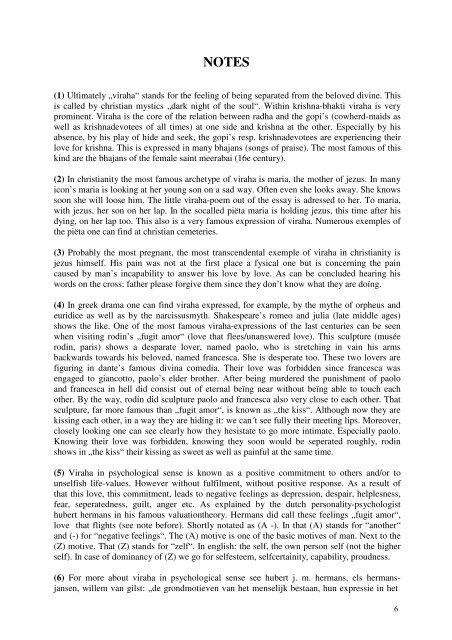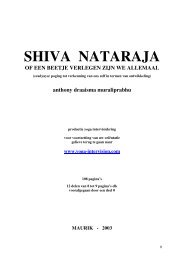viraha, sweet pain of unanswered love - Yoga Intervision
viraha, sweet pain of unanswered love - Yoga Intervision
viraha, sweet pain of unanswered love - Yoga Intervision
You also want an ePaper? Increase the reach of your titles
YUMPU automatically turns print PDFs into web optimized ePapers that Google loves.
NOTES<br />
(1) Ultimately „<strong>viraha</strong>“ stands for the feeling <strong>of</strong> being separated from the be<strong>love</strong>d divine. This<br />
is called by christian mystics „dark night <strong>of</strong> the soul“. Within krishna-bhakti <strong>viraha</strong> is very<br />
prominent. Viraha is the core <strong>of</strong> the relation between radha and the gopi’s (cowherd-maids as<br />
well as krishnadevotees <strong>of</strong> all times) at one side and krishna at the other. Especially by his<br />
absence, by his play <strong>of</strong> hide and seek, the gopi’s resp. krishnadevotees are experiencing their<br />
<strong>love</strong> for krishna. This is expressed in many bhajans (songs <strong>of</strong> praise). The most famous <strong>of</strong> this<br />
kind are the bhajans <strong>of</strong> the female saint meerabai (16e century).<br />
(2) In christianity the most famous archetype <strong>of</strong> <strong>viraha</strong> is maria, the mother <strong>of</strong> jezus. In many<br />
icon’s maria is looking at her young son on a sad way. Often even she looks away. She knows<br />
soon she will loose him. The little <strong>viraha</strong>-poem out <strong>of</strong> the essay is adressed to her. To maria,<br />
with jezus, her son on her lap. In the socalled piëta maria is holding jezus, this time after his<br />
dying, on her lap too. This also is a very famous expression <strong>of</strong> <strong>viraha</strong>. Numerous exemples <strong>of</strong><br />
the piëta one can find at christian cemeteries.<br />
(3) Probably the most pregnant, the most transcendental exemple <strong>of</strong> <strong>viraha</strong> in christianity is<br />
jezus himself. His <strong>pain</strong> was not at the first place a fysical one but is concerning the <strong>pain</strong><br />
caused by man’s incapability to answer his <strong>love</strong> by <strong>love</strong>. As can be concluded hearing his<br />
words on the cross: father please forgive them since they don’t know what they are doïng.<br />
(4) In greek drama one can find <strong>viraha</strong> expressed, for example, by the mythe <strong>of</strong> orpheus and<br />
euridice as well as by the narcissusmyth. Shakespeare’s romeo and julia (late middle ages)<br />
shows the like. One <strong>of</strong> the most famous <strong>viraha</strong>-expressions <strong>of</strong> the last centuries can be seen<br />
when visiting rodin’s „fugit amor“ (<strong>love</strong> that flees/<strong>unanswered</strong> <strong>love</strong>). This sculpture (musée<br />
rodin, paris) shows a desparate <strong>love</strong>r, named paolo, who is stretching in vain his arms<br />
backwards towards his be<strong>love</strong>d, named francesca. She is desperate too. These two <strong>love</strong>rs are<br />
figuring in dante’s famous divina comedia. Their <strong>love</strong> was forbidden since francesca was<br />
engaged to giancotto, paolo’s elder brother. After being murdered the punishment <strong>of</strong> paolo<br />
and francesca in hell did consist out <strong>of</strong> eternal beïng near without beïng able to touch each<br />
other. By the way, rodin did sculpture paolo and francesca also very close to each other. That<br />
sculpture, far more famous than „fugit amor“, is known as „the kiss“. Although now they are<br />
kissing each other, in a way they are hiding it: we can´t see fully their meeting lips. Moreover,<br />
closely looking one can see clearly how they hesistate to go more intimate. Especially paolo.<br />
Knowing their <strong>love</strong> was forbidden, knowing they soon would be seperated roughly, rodin<br />
shows in „the kiss“ their kissing as <strong>sweet</strong> as well as <strong>pain</strong>ful at the same time.<br />
(5) Viraha in psychological sense is known as a positive commitment to others and/or to<br />
unselfish life-values. However without fulfilment, without positive response. As a result <strong>of</strong><br />
that this <strong>love</strong>, this commitment, leads to negative feelings as depression, despair, helplesness,<br />
fear, seperatedness, guilt, anger etc. As explained by the dutch personality-psychologist<br />
hubert hermans in his famous valuationtheory. Hermans did call these feelings „fugit amor“,<br />
<strong>love</strong> that flights (see note before). Shortly notated as (A -). In that (A) stands for “another“<br />
and (-) for “negative feelings“. The (A) motive is one <strong>of</strong> the basic motives <strong>of</strong> man. Next to the<br />
(Z) motive. That (Z) stands for “zelf“. In english: the self, the own person self (not the higher<br />
self). In case <strong>of</strong> dominancy <strong>of</strong> (Z) we go for selfesteem, selfcertainity, capability, proudness.<br />
(6) For more about <strong>viraha</strong> in psychological sense see hubert j. m. hermans, els hermans-<br />
jansen, willem van gilst: „de grondmotieven van het menselijk bestaan, hun expressie in het<br />
6






